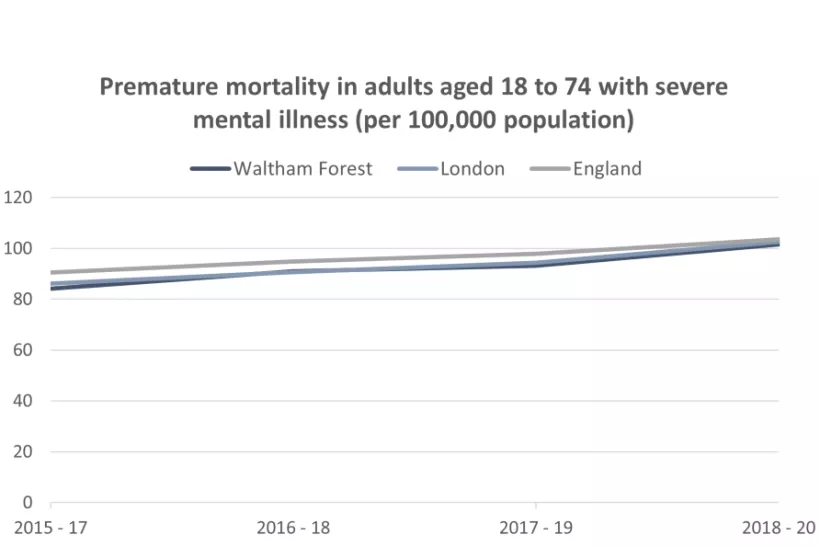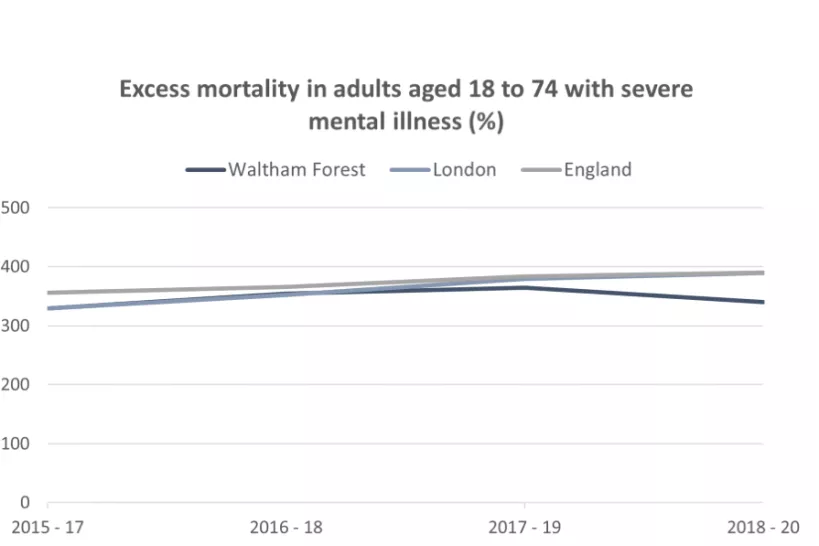Last updated: 17 July 2024
Next review: 17 July 2025
This content is part of the Waltham Forest JSNA. To see other JSNA content, visit the JSNA landing page
Premature mortality in adults with severe mental illness
The term severe mental illness (SMI) is used to describe people with a group of conditions that are often chronic and debilitating, and which limit their ability to engage in regular day-to-day activities is severely impaired [1]. SMI generally includes diagnoses such as schizophrenia, bipolar disorder or other psychotic illnesses.
People with SMI make more use of secondary urgent and emergency care, and experience higher premature mortality rates; compared with the general population, people with a long-standing mental health problem are twice as likely to smoke, with the highest rates among people with psychosis or bipolar disorder. Patients with SMI are also at substantially higher risk of obesity, asthma, diabetes, chronic obstructive pulmonary disease (COPD) and cardiovascular disease. [2]
Rates of premature mortality of adults with SMI have generally been increasing over the last five years across England, London and Waltham Forest, increasing from around 90 per 100,000 to around 100 per 100,000 in England. Similar to other premature mortality indicators, Waltham Forest has a similar but slightly lower rate of premature mortality (101.5 per 100,000 compared to 102.5 and 103.6 in London and England respectively).
The most deprived areas have an SMI premature mortality rate that is almost four times higher than the least deprived areas. Males also having significantly higher rates of SMI premature mortality compared to females.

Source: OHID Public Health Outcomes Framework. Data from NHS Digital Mental Health Services Dataset and ONS. Date accessed: 7 July 2023.
Note: For this indicator, SMI is defined as having a referral to mental health services in the five years preceding death. Variations in access to mental health services and referral practice in different areas will affect the indicator meaning comparisons between areas need to be treated with caution
Excess premature mortality rate in adults with severe mental illness
This indicator measures excess premature mortality experienced by adults with severe mental illness compared to adults without SMI, expressed as a percentage. Higher values of this indicator indicate higher rates of mortality being experienced by the SMI population. Note that areas with good access to services will have more of their population in the SMI cohort, which may have an impact on the mortality rate.
In 2018 to 2020, the excess risk for mortality in adults with SMI in Waltham Forest was 340% compared to 389% in London and 390% across England. While the 2018 to 2020 figure represents a small decline from the previous period in Waltham Forest, the figure remains statistically similar to the national average.

Source: OHID Public Health Outcomes Framework. Data from NHS Digital Mental Health Services Dataset and ONS. Date accessed: 7 July 2023.
References
[1] Public Health England (2018). Severe mental illness (SMI) and physical health inequalities: briefing. Date accessed: 7 July 2023.
[2] OHID Fingertips - Public Health Outcomes Framework. Date accessed: 4 June 2023.